-
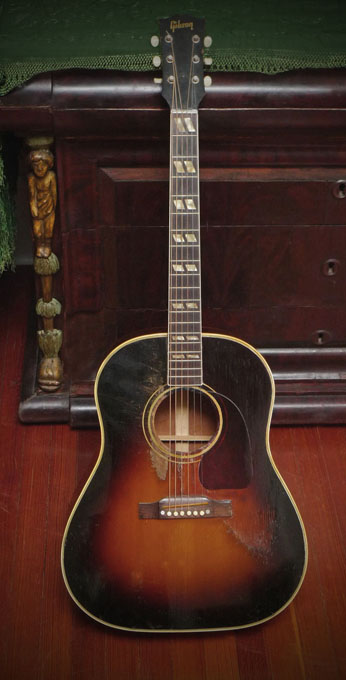 Crack-free, and superb tone. One of the finest sounding large bodied Gibsons we’ve ever heard.
Crack-free, and superb tone. One of the finest sounding large bodied Gibsons we’ve ever heard. -
 A wonderfully balanced and resonant Martin 00-28G, with some of the most beautiful Brazilian rosewood you’ll see on any Martin guitar, and in wonderful, crack-free, original condition. The Martin “G” is very different from the “C”. The “C” has the Martin 12 fret body. The “G” model used the 14-fret style body shape, but with the 12 fret neck, slotted headstock, and 25.4 inch scale. The 00-28G was first produced by Martin in 1936, and was discontinued in 1962, when Martin went to all “C” style for nylon string guitars. The 00-28G was Martin’s top of line model for nylon strings, from 1936, to 1962… and this guitar is the best example available on the market. The condition on this instrument is superb. No cracks anywhere, and very little wear at all... it's almost perfect. All original, tuners, nut, bridge, saddle, etc. Neck is perfect, has never been set, and shows perfect set up and action.
A wonderfully balanced and resonant Martin 00-28G, with some of the most beautiful Brazilian rosewood you’ll see on any Martin guitar, and in wonderful, crack-free, original condition. The Martin “G” is very different from the “C”. The “C” has the Martin 12 fret body. The “G” model used the 14-fret style body shape, but with the 12 fret neck, slotted headstock, and 25.4 inch scale. The 00-28G was first produced by Martin in 1936, and was discontinued in 1962, when Martin went to all “C” style for nylon string guitars. The 00-28G was Martin’s top of line model for nylon strings, from 1936, to 1962… and this guitar is the best example available on the market. The condition on this instrument is superb. No cracks anywhere, and very little wear at all... it's almost perfect. All original, tuners, nut, bridge, saddle, etc. Neck is perfect, has never been set, and shows perfect set up and action. -
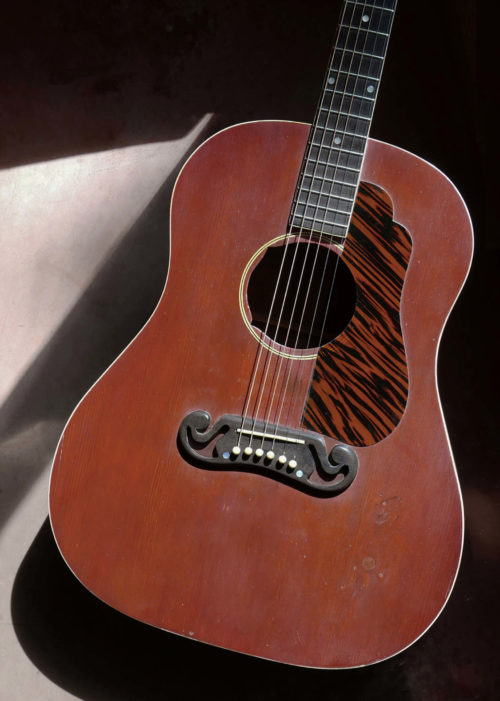 This is not your father’s J-55. And it’s not a $20K guitar. It is a wonderful player. This is an original 1939 Gibson Jumbo 55, also called the “J-55”, serial # EA5652. It is the rare, stair step headstock model, only made for a brief window in the late 30’s. It delivers the trademark, large body, prewar, long scale Gibson tone, like no other. It plays beautifully, with original bridge, frets, braces. This guitar has of course the original, Mustache bridge, and more rare– the stair step headstock. Original bridge plate. Original binding including on fretboard. Original pearl logo on the headstock (with original finish). The pickguard is a nitro cellulose reproduction meticulously crafted in our shop. It has the long scale, 25 ½ inches, that makes this model so great. And a little-known original feature of this rare model is that it has a 1 11/16 nut width, that combined with the low action makes it effortless to play, and with tone that cannot be equaled in any postwar Gibson. The intonation is spot-on, and the intonation and fretting/action are great even at the high fret positions. It was refinished in a deep Gibsonesque red, decades ago– and that makes this guitar the most affordable true 1939, stairstep headstock J-55 you will ever find. (Top thickness is fine, there was no thinning in the past). The tone is superb. And the action is superb– low and fast without sacrificing tone or volume at all.
This is not your father’s J-55. And it’s not a $20K guitar. It is a wonderful player. This is an original 1939 Gibson Jumbo 55, also called the “J-55”, serial # EA5652. It is the rare, stair step headstock model, only made for a brief window in the late 30’s. It delivers the trademark, large body, prewar, long scale Gibson tone, like no other. It plays beautifully, with original bridge, frets, braces. This guitar has of course the original, Mustache bridge, and more rare– the stair step headstock. Original bridge plate. Original binding including on fretboard. Original pearl logo on the headstock (with original finish). The pickguard is a nitro cellulose reproduction meticulously crafted in our shop. It has the long scale, 25 ½ inches, that makes this model so great. And a little-known original feature of this rare model is that it has a 1 11/16 nut width, that combined with the low action makes it effortless to play, and with tone that cannot be equaled in any postwar Gibson. The intonation is spot-on, and the intonation and fretting/action are great even at the high fret positions. It was refinished in a deep Gibsonesque red, decades ago– and that makes this guitar the most affordable true 1939, stairstep headstock J-55 you will ever find. (Top thickness is fine, there was no thinning in the past). The tone is superb. And the action is superb– low and fast without sacrificing tone or volume at all. -
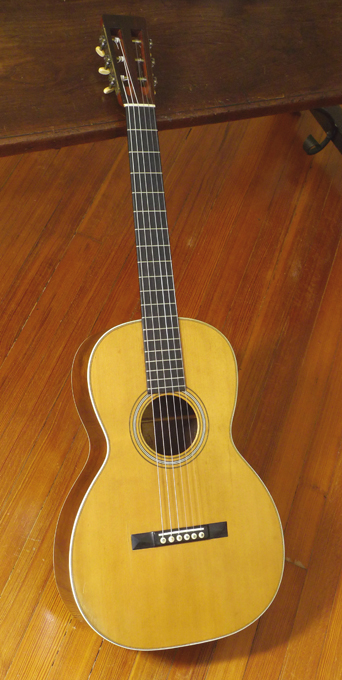 Signed by Martin factory foreman, underside of top: “Dec. 8, 1893”, this 0-28 is in wonderful original condition.
Signed by Martin factory foreman, underside of top: “Dec. 8, 1893”, this 0-28 is in wonderful original condition.- Instrument is 100% original: finish, bridge, ivory nut, ivory saddle, ivory bridge pins, bar frets
- Brazilian Rosewood Back and Sides
- Adirondack Spruce top
- Shows very little wear
- Scalloped braces (X-braced)
- Original maple bridge plate in perfect condition
- Original French-polish shellac finish throughout
- 13.5" wide at lower bout, and 4.25" deep at the endpin
- 24.9" scale length
- 1-7/8" wide nut
- Soft-V neck profile
- A couple small top cracks, professionally repaired and not an issue. Two finish checks/cracks, that due not go through wood, on back
-
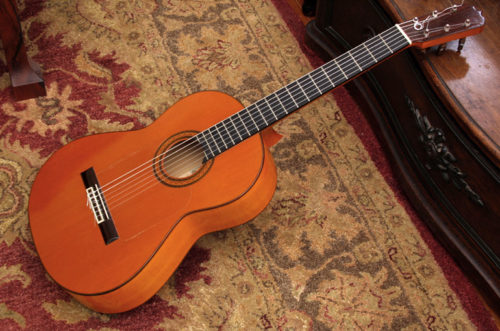 Martin established the X-brace as the standard in American guitars, but that was never pre-ordained, or set in stone. The fan-bracing of the Spanish guitar has equally appealing qualities, and is a century-plus long standard that continues to dominate the design of the classical and flamenco guitar. Not an “Estudio” (student) model, this is the top of line model, 1a Ramirez flamenco. If you’ve never played one of these exquisite cypress Ramirez flamenco guitars–you’ll be surprised at the tone. Spanish cypress back and sides. Cedar top. First of all, the guitar is so light. It floats in your hands, yet it’s tight as a drum. It’s one of the lightest guitars you will ever play (due to the lightness of the wood, and also to the use of tuning pegs–so that the head and neck of the guitar are not pulled down by gravity, allowing the head to float effortlessly at about eye level. And the raspy bass is unbelievable. It’s all about that percussive tone and throaty bass. Conventional wisdom says rosewood for a “classical” guitar, for sustain; and cypress for a flamenco guitar, for the percussive, throaty quality, and more volume. Action is low, as it should be for flamenco. And that wonderful wide nut (2-1/8 inch), you’ve got so much room to move on this beautiful ebony fingerboard. Original finish. As with almost all these old Ramirez flamencos with the tap plate on top, there are shallow, thin hairline cracks where the top edge, and bottom edge, of the tap plate (clear plastic) meets the top (similar to the small cracks you get on an old martin, due to the guard being glued to the top). There is also a six-inch long hairline finish crack on the top above and parallel to the fingerboard (does not go through the wood), and a 3-inch long hairline finish crack below the fingerboard. A few dings here and there, but finish is that original, beautiful high polish reddish-amber.
Martin established the X-brace as the standard in American guitars, but that was never pre-ordained, or set in stone. The fan-bracing of the Spanish guitar has equally appealing qualities, and is a century-plus long standard that continues to dominate the design of the classical and flamenco guitar. Not an “Estudio” (student) model, this is the top of line model, 1a Ramirez flamenco. If you’ve never played one of these exquisite cypress Ramirez flamenco guitars–you’ll be surprised at the tone. Spanish cypress back and sides. Cedar top. First of all, the guitar is so light. It floats in your hands, yet it’s tight as a drum. It’s one of the lightest guitars you will ever play (due to the lightness of the wood, and also to the use of tuning pegs–so that the head and neck of the guitar are not pulled down by gravity, allowing the head to float effortlessly at about eye level. And the raspy bass is unbelievable. It’s all about that percussive tone and throaty bass. Conventional wisdom says rosewood for a “classical” guitar, for sustain; and cypress for a flamenco guitar, for the percussive, throaty quality, and more volume. Action is low, as it should be for flamenco. And that wonderful wide nut (2-1/8 inch), you’ve got so much room to move on this beautiful ebony fingerboard. Original finish. As with almost all these old Ramirez flamencos with the tap plate on top, there are shallow, thin hairline cracks where the top edge, and bottom edge, of the tap plate (clear plastic) meets the top (similar to the small cracks you get on an old martin, due to the guard being glued to the top). There is also a six-inch long hairline finish crack on the top above and parallel to the fingerboard (does not go through the wood), and a 3-inch long hairline finish crack below the fingerboard. A few dings here and there, but finish is that original, beautiful high polish reddish-amber. -
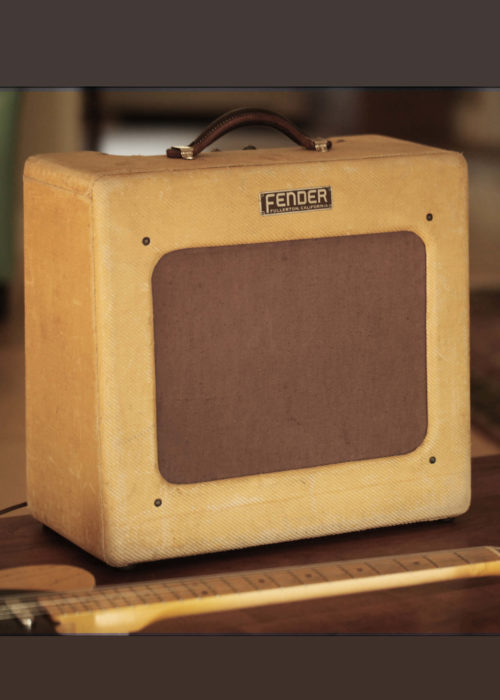 1951 Fender Deluxe Amplifier ... all it should be, and more... coming soon... . .
1951 Fender Deluxe Amplifier ... all it should be, and more... coming soon... . . -
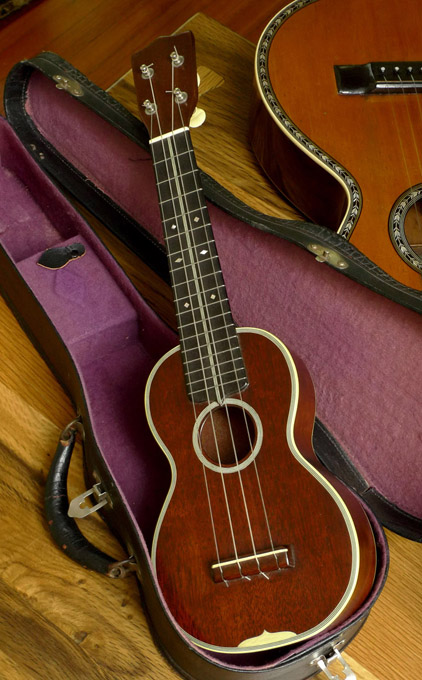 In the 1920’s and early 30's, the Hawaiian craze was in full bloom, and ukulele production was crucial to Martin’s success in this period. This is a wonderful, extremely well-preserved example of one of the most ornate of the Martin ukuleles, still in its original Geib case. Although Martin ukes built after 1916 carried no serial number, it’s possible to generally date them by stylistic elements. This Martin Style 3 is from the best era, the golden era, from about 1925 to 1930. Martin style 3 was first made in 1918. Martin Style 3, soprano (standard) specs:
In the 1920’s and early 30's, the Hawaiian craze was in full bloom, and ukulele production was crucial to Martin’s success in this period. This is a wonderful, extremely well-preserved example of one of the most ornate of the Martin ukuleles, still in its original Geib case. Although Martin ukes built after 1916 carried no serial number, it’s possible to generally date them by stylistic elements. This Martin Style 3 is from the best era, the golden era, from about 1925 to 1930. Martin style 3 was first made in 1918. Martin Style 3, soprano (standard) specs:- Mahogany body
- 7 layer top binding
- 3 layer back binding
- Ebony fretboard
- 5 layer soundhole ring
- Celluloid ornament on top, behind bridge (known as the "parend", or “shield”)
- Bar frets
- Small pearl paired-diamond inlays at fret 5, 7, and 9
- Three lines inlaid down center of fingerboard
- Nickel plated pegs (introduced in 1923)
- CF Martin & Co, stamped on back of peghead, and inside-back (Martin logo was not put on front of peghead until 1932)
-
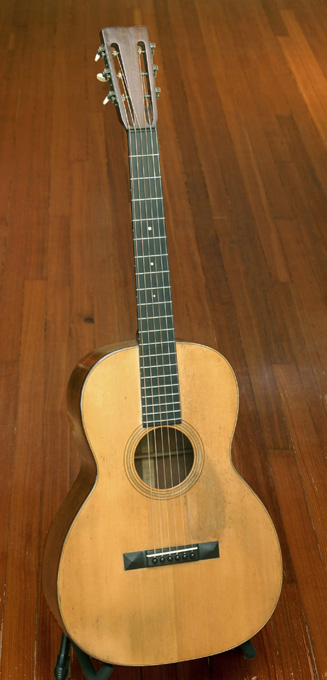 A steel-string braced 00-18, with finely scalloped braces, and light as a feather. No wonder the tone is exquisite. This 12-fret gem, from the best era for Martin12-frets, resonates in your hands (say what you want about the 30’s, but the more lightly-built Martins of the 20’s become an extension of your body). The set up is low (4 to 5 64ths), so it plays like a dream. Original finish throughout. Mahogany back and sides. Adirondack spruce top. Ebony fingerboard. Original tuners/gear wheel below worm gear, ivoroid buttons. The instrument was acquired from one of North America’s top Martin restoration shops, Folkway Music, who reported: “This 00-18 went back to Martin in the late 80's for a neck reset, refret, re-bridge, and a new bridge plate. The back has one repaired crack, and there are two well repaired side cracks. Martin's repairs are well done, the new bar frets are nice and tall, and the bridge plate (maple) is only slightly oversized. The somewhat oversized pyramid bridge didn't look great when the guitar came in, so we re-profiled it here in shop and fitted a new bone saddle and vintage-correct bridge-pins.” This instrument will not disappoint. It has been correctly and meticulously restored by Martin, and by one of the world’s top Martin experts. It’s ready for decades of enjoyment.
A steel-string braced 00-18, with finely scalloped braces, and light as a feather. No wonder the tone is exquisite. This 12-fret gem, from the best era for Martin12-frets, resonates in your hands (say what you want about the 30’s, but the more lightly-built Martins of the 20’s become an extension of your body). The set up is low (4 to 5 64ths), so it plays like a dream. Original finish throughout. Mahogany back and sides. Adirondack spruce top. Ebony fingerboard. Original tuners/gear wheel below worm gear, ivoroid buttons. The instrument was acquired from one of North America’s top Martin restoration shops, Folkway Music, who reported: “This 00-18 went back to Martin in the late 80's for a neck reset, refret, re-bridge, and a new bridge plate. The back has one repaired crack, and there are two well repaired side cracks. Martin's repairs are well done, the new bar frets are nice and tall, and the bridge plate (maple) is only slightly oversized. The somewhat oversized pyramid bridge didn't look great when the guitar came in, so we re-profiled it here in shop and fitted a new bone saddle and vintage-correct bridge-pins.” This instrument will not disappoint. It has been correctly and meticulously restored by Martin, and by one of the world’s top Martin experts. It’s ready for decades of enjoyment. -
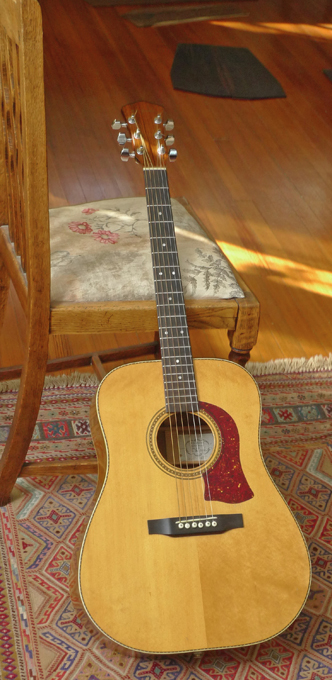 Stuart Mossman was one the country’s top luthiers in the 1970s and 80s– working in the tradition of the great American Dreadnought. According to an article in Vintage Guitar magazine: Stuart Mossman “…. began making guitars in 1965 and through his early efforts concentrated on experimenting with bracing of the tops. He spent four years building 40 or 50 prototypes in his garage at home. By the end of the decade, sensing a niche in the market for high quality handmade acoustics, he had incorporated S. L. Mossman Guitars in Winfield, Kansas and moved into facilities at Strother's Field outside of town. Mossman had noticed what was happening with major acoustic guitar manufacturers at the time. The folk music boom had pushed demand for acoustic instruments to an all-time high and while Gibson, Martin and Guild were increasing production, imports from the Pacific rim countries were beginning to exploit the lower end of the market. Mossman was concerned with what he saw as an erosion in materials, design, and craftsmanship in the construction of the traditional flattop acoustic guitar, particularly among the larger manufacturers as they rushed to meet the strong demand. Using only top-quality woods, a proprietary bracing structure, and old-world building techniques, Mossman guitars entered series production in 1970. ‘We were the first of the small manufacturers to make it as a larger company', Stuart Mossman recalls…” The original 70’s Mossman dreadnoughts are very well built, with attention to detail, and craftsmanship unsurpassed in this period. One of the hallmarks of the Mossman guitar is that each instruments has a paper label inside, with the serial number (that included the year date) and model. And the label was always signed or initialed by the craftsmen building that guitar (this one includes Stu Mossman’s initials: SLM). The Flint Hills model featured East Indian Rosewood back and sides, spruce top, ebony fretboard and bridge, and a unique inlay around the soundhole. This example is all original, and is in fine condition, with no cracks. Original West German Schaler tuners. It has an under-saddle pickup installed, and an input jack in the end pin. Tone is fine, and loud, reminiscent of a 60’s Martin– but with a little more punch in the mids and trebles– a perfect bluegrass instrument.
Stuart Mossman was one the country’s top luthiers in the 1970s and 80s– working in the tradition of the great American Dreadnought. According to an article in Vintage Guitar magazine: Stuart Mossman “…. began making guitars in 1965 and through his early efforts concentrated on experimenting with bracing of the tops. He spent four years building 40 or 50 prototypes in his garage at home. By the end of the decade, sensing a niche in the market for high quality handmade acoustics, he had incorporated S. L. Mossman Guitars in Winfield, Kansas and moved into facilities at Strother's Field outside of town. Mossman had noticed what was happening with major acoustic guitar manufacturers at the time. The folk music boom had pushed demand for acoustic instruments to an all-time high and while Gibson, Martin and Guild were increasing production, imports from the Pacific rim countries were beginning to exploit the lower end of the market. Mossman was concerned with what he saw as an erosion in materials, design, and craftsmanship in the construction of the traditional flattop acoustic guitar, particularly among the larger manufacturers as they rushed to meet the strong demand. Using only top-quality woods, a proprietary bracing structure, and old-world building techniques, Mossman guitars entered series production in 1970. ‘We were the first of the small manufacturers to make it as a larger company', Stuart Mossman recalls…” The original 70’s Mossman dreadnoughts are very well built, with attention to detail, and craftsmanship unsurpassed in this period. One of the hallmarks of the Mossman guitar is that each instruments has a paper label inside, with the serial number (that included the year date) and model. And the label was always signed or initialed by the craftsmen building that guitar (this one includes Stu Mossman’s initials: SLM). The Flint Hills model featured East Indian Rosewood back and sides, spruce top, ebony fretboard and bridge, and a unique inlay around the soundhole. This example is all original, and is in fine condition, with no cracks. Original West German Schaler tuners. It has an under-saddle pickup installed, and an input jack in the end pin. Tone is fine, and loud, reminiscent of a 60’s Martin– but with a little more punch in the mids and trebles– a perfect bluegrass instrument. -
Out of stock
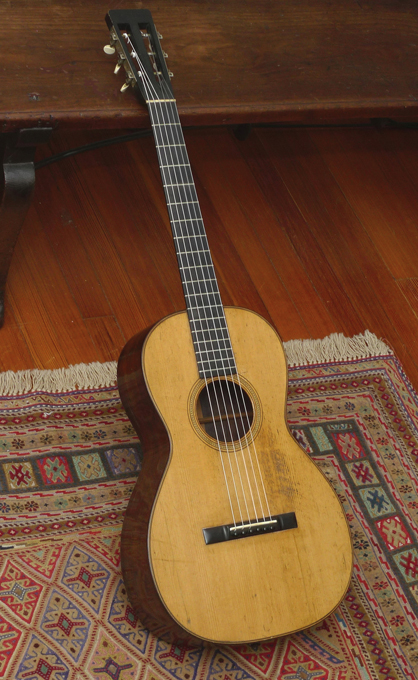 1855-1860 Martin “transitional”1-21. A very rare and exquisite large size Martin from the pre-1867 era. “Large size” Martin from the 1850’s, because the Size 1, and 0, were the only “large” size Martins in those years. And there is currently not a single other size 1 or 0 size pre-1867 Martin guitar on the market. This is considered by the top U.S. experts who vetted this instrument as an early, rare "transitional" 1-21, based on the fact that it does not have all the later, standardized, 1860’s and on “21” attributes– specifically, backstrip and endwedge on this instrument are not typical of “price-list” era 21’s (after the publishing of the first Martin price lists, establishing features of the different models, in the 1860’s) This 1-21 has:
1855-1860 Martin “transitional”1-21. A very rare and exquisite large size Martin from the pre-1867 era. “Large size” Martin from the 1850’s, because the Size 1, and 0, were the only “large” size Martins in those years. And there is currently not a single other size 1 or 0 size pre-1867 Martin guitar on the market. This is considered by the top U.S. experts who vetted this instrument as an early, rare "transitional" 1-21, based on the fact that it does not have all the later, standardized, 1860’s and on “21” attributes– specifically, backstrip and endwedge on this instrument are not typical of “price-list” era 21’s (after the publishing of the first Martin price lists, establishing features of the different models, in the 1860’s) This 1-21 has:- Diamond marquetry backstrip (not found on later, 1860’s 1-21s)
- Marquetry endwedge (not found on later, 1860’s 1-21s) (Wood end wedge and herringbone backstrip were the standard features of the 1860’s and after 1-21’s)
- X-braced. All braces are 100% original. No internal repairs to braces.
- Slot head
- Ebonized neck (maple neck, ebonized, i.e. painted black). This is another transitional feature: black neck was replaced by cedar on Style 21 by the time the Martin price list was first printed.
- Single "tone bar" brace behind the bridge plate
- Ice cream cone-shaped heel (1860’s 1-21’s had cedar neck, with Spanish style heel not ice cream cone heel)
- Three "CF Martin New-York" stamps: one inside center strip; the second on neck block (this stamp is upside down, as it should be); the third on back of guitar (near heel), the third stamp transversing the backstrip on the back of the guitar near the heel.
- Solid Brazilian Rosewood back and sides
- All original finish, everywhere; no touch-ups, overspray, etc, of any kind ever done
- Brazilian rosewood back shows beautiful sawmarks
- Bridge, more than a century old, is probably a replacement bridge… but on the original bridge footprint
- Original ivory nut
- Original bridge plate (mahogany)
- No back cracks, or side cracks; one top crack, repaired
- Tuners are modern replacements, vintage style, in original slot holes
- Original frets
-
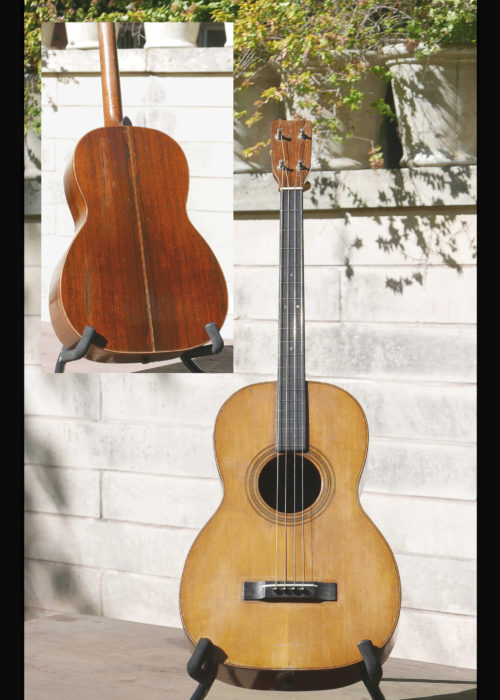 The 5-21 Martins, with their Brazilian Rosewood back and sides and Adirondack spruce tops, are known for putting out an astounding amount of sound. This tenor guitar, style 5-21T, does that in spades. Measuring 11-3/8" across, with its X braced top and light build, the instrument has an amazing amount of tone. Though Martin offered size 5 models ranging from style 15 through the elaborately ornamented style 45, the only ones made in any significant quantity prior to World War II were the style 17, 18, and 21 in six-string guitars and styles 17, 18, and 21 tenors, as well as some style 15 post-war size 5 tenors. Features of this instrument:
The 5-21 Martins, with their Brazilian Rosewood back and sides and Adirondack spruce tops, are known for putting out an astounding amount of sound. This tenor guitar, style 5-21T, does that in spades. Measuring 11-3/8" across, with its X braced top and light build, the instrument has an amazing amount of tone. Though Martin offered size 5 models ranging from style 15 through the elaborately ornamented style 45, the only ones made in any significant quantity prior to World War II were the style 17, 18, and 21 in six-string guitars and styles 17, 18, and 21 tenors, as well as some style 15 post-war size 5 tenors. Features of this instrument:- Recent neck set, and leveling of original bar frets, action is very good
- Original Grover tuning machines, working well
- Nut width of 1 1/4"
- Scale length: 22.5"
- 1 3/8" string spacing at the saddle
- Had an added tailpiece at once point (3 tiny screw holes near end pin
- No top cracks
- One repaired 11" crack on the bottom lower bout side
- One 6" repaired crack on the upper bout back under the herring bone center inlay,
- One 4” repaired crack on the lower bout back towards the bottom
- A small hole at the center of the rear headstock– probably at some point for a nail to hang the instrument on a wall
- Neck has a comfortable V shape, leaning toward a U profile
-
 Very few modern luthiers have captured that Larson Brothers sustain and what I call “shimmer” with a new build. This guitar, built by the master luthier Hans Brentrup in late 2009, has it in spades. We’ve never played anything but a 30’s Larson Bros’ that has the sustain this guitar has. Hans’ unique tone bars do what only the Larson tone bar system did– get the body of the guitar to sustain and impart that wonderful shimmer to the trebles especially.
Very few modern luthiers have captured that Larson Brothers sustain and what I call “shimmer” with a new build. This guitar, built by the master luthier Hans Brentrup in late 2009, has it in spades. We’ve never played anything but a 30’s Larson Bros’ that has the sustain this guitar has. Hans’ unique tone bars do what only the Larson tone bar system did– get the body of the guitar to sustain and impart that wonderful shimmer to the trebles especially.- Brazilian Rosewood back and sides
- Engelmann spruce top
- 000 size
- 25.34 scale length
- Easily accommodates Medium or Heavy strings
- Hybrid ladder laminated bracing with Carbon fiber “Tone tubes”
- Mahogany neck
- Slotted headstock
- Golden Age tuners
- Ebony fingerboard with MOP dots
- Pyramid bridge
- Tortoise body binding
- Lacquer finish